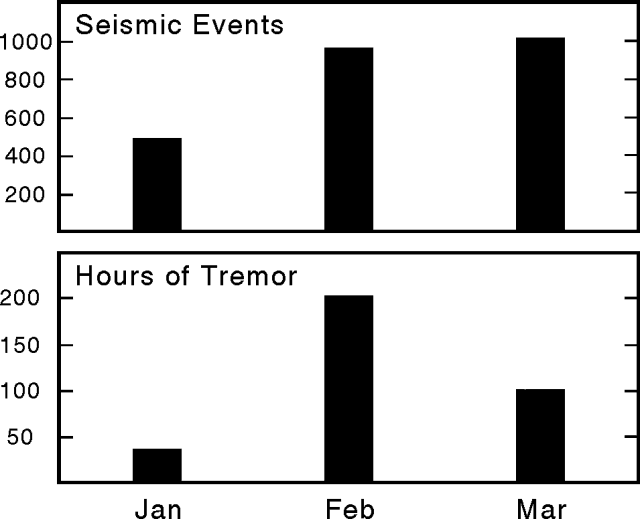Report on Arenal (Costa Rica) — March 1994
Bulletin of the Global Volcanism Network, vol. 19, no. 3 (March 1994)
Managing Editor: Richard Wunderman.
Arenal (Costa Rica) Vigorous venting of gas and emission of lava flows from Crater C
Please cite this report as:
Global Volcanism Program, 1994. Report on Arenal (Costa Rica) (Wunderman, R., ed.). Bulletin of the Global Volcanism Network, 19:3. Smithsonian Institution. https://doi.org/10.5479/si.GVP.BGVN199403-345033
Arenal
Costa Rica
10.463°N, 84.703°W; summit elev. 1670 m
All times are local (unless otherwise noted)
In March, . . . Crater C continued to emit gases, lava, and sporadic Strombolian eruptions. Lava progressing toward the NE and the Tabacón valley flowed along the same drainages in early 1994 as in 1993. A lobe branched off at 840 m elev and advanced separately. The front of the older, main flow has remained stationary at 620 m elev, 2.4 km from the source vent. Ash columns ascended up to 1 km above crater C; falling blocks and bombs reached 1,100 m elev (several hundred meters above the base of the edifice). Near the explosive vent, the erupted material built a small, blocky, dome-like structure. During March the seismic station VACR recorded 1,011 seismic events and 101 hours of tremor (figure 68). Sampling in early April revealed no new changes in temperature or acidity of hot and cold springs around the volcano.
 |
Figure 68. Arenal seismic events and duration of tremor for January, February, and March of 1994 (received at station "VACR," 2.7 km NW of the active crater). Courtesy of OVSICORI. |
Geological Summary. Conical Volcán Arenal is the youngest stratovolcano in Costa Rica and one of its most active. The 1670-m-high andesitic volcano towers above the eastern shores of Lake Arenal, which has been enlarged by a hydroelectric project. Arenal lies along a volcanic chain that has migrated to the NW from the late-Pleistocene Los Perdidos lava domes through the Pleistocene-to-Holocene Chato volcano, which contains a 500-m-wide, lake-filled summit crater. The earliest known eruptions of Arenal took place about 7000 years ago, and it was active concurrently with Cerro Chato until the activity of Chato ended about 3500 years ago. Growth of Arenal has been characterized by periodic major explosive eruptions at several-hundred-year intervals and periods of lava effusion that armor the cone. An eruptive period that began with a major explosive eruption in 1968 ended in December 2010; continuous explosive activity accompanied by slow lava effusion and the occasional emission of pyroclastic flows characterized the eruption from vents at the summit and on the upper western flank.
Information Contacts: G. Soto, G. Alvarado, and F. Arias, ICE; E. Fernández, J. Barquero, R. Van der Laat, F. de Obaldia, T. Marino, V. Barboza, and R. Sáenz, OVSICORI.

